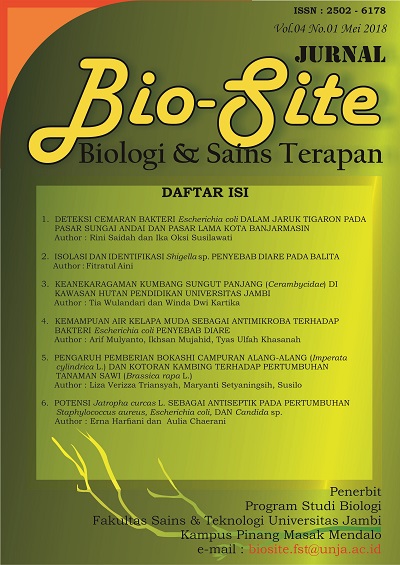POTENSI Jatropha curcas L. SEBAGAI ANTISEPTIK PADA PERTUMBUHAN Staphylococcus aureus, Escherichia coli, dan Candida sp.
DOI:
https://doi.org/10.22437/bs.v4i1.4931Abstrak
Skin disease is still a health problem in the world, especially tropical countries, including Indonesia, it needs normal control of flora among others with antiseptic. Jatropha curcas L., which contains secondary metabolite compounds suspected as an antiseptic on the skin. The study aimed to evaluate Jatropha sap can inhibit the growth of Staphylococcus aureus, Escherichia coli, and Candida albicans, and to know the optimal concentration of Jatropha curcas by invitro. The antiseptic activity of Jatropha sap was tested using agar diffusion method (Kirby-Bauer) with Mueller Hinton Agar medium and Saboround Dextrose Agar at concentrations 20%, 40%, 60%, 80% and 100. The results showed that Jatropha sap can inhibit the growth of Staphylococcus aureus, and Escherichia coli but not in Candida albicans. Treatment of 100% Jatropha sap concentration is the most optimal concentration in inhibiting the growth of Staphylococcus aureus, and Escherichia coli with an inhibitory zone of 9.75 ± 0.27 mm (medium antiseptic power) and 10.61 ± 0.2 mm (strong antiseptic power). The results show that the sap of Jatropha curcas L. grown in Indonesia has a good potential to be used as an antiseptic made from nature.
Penyakit pada kulit masih merupakan masalah kesehatan di dunia terutama negara beriklim tropis, termasuk Indonesia, sehingga diperlukan pengendalian flora normal diantaranya dengan antiseptik. Getah jarak pagar (Jatropha curcas L.) yang mengandung senyawa metabolit sekunder diduga berfungsi sebagai antiseptik pada kulit. Penelitian bertujuan mengevaluasi apakah getah jarak pagar dapat menghambat pertumbuhan Staphylococcus aureus, Escherichia coli dan Candida albicans, dan mengetahui konsentrasi optimal getah jarak pagar secara invitro. Aktivitas antiseptik getah jarak pagar diuji dengan menggunakan metode difusi agar (Kirby-Bauer) dengan medium Mueller Hinton Agar (MHA) dan Saboround Dextrose Agar (SDA) pada konsentrasi 20%, 40%, 60%, 80% dan 100. Hasil penelitian menunjukkan getah jarak pagar dapat menghambat pertumbuhan bakteri Staphylococcus aureus, dan Escherichia coli namun tidak pada jamur Candida albicans. Perlakuan getah jarak pagar konsentrasi 100% merupakan konsentrasi paling optimal dalam menghambat pertumbuhan Staphylococcus aureus, dan Escherichia coli dengan zona hambat 9,75 ± 0,27 mm (daya antiseptik sedang) dan 10,61 0,2 mm (daya antiseptik kuat). Hasil menunjukkan getah jarak pagar yang banyak tumbuh di Indonesia mempunyai potensi yang cukup baik untuk dipergunakan sebagai antiseptik berbahan alam.
Keyword: Antiseptik, Escherichia coli, Candida albicans, Jarak pagar (Jatropha curcas L.), Staphylococcus aureus
Unduhan
##submission.downloads##
Diterbitkan
Versi
- 2019-01-16 (1)
- 2019-01-16 (1)
Cara Mengutip
Terbitan
Bagian
Lisensi
This work is licensed under a Creative Commons Attribution 4.0 International License.
Copyright Notice:
1. Authors retain copyright and grant the journal right of first publication with the work simultaneously licensed under a Creative Commons Attribution 4.0 International License that allows others to share the work with an acknowledgement of the work's authorship and initial publication in this journal.
2. Authors are able to enter into separate, additional contractual arrangements for the non-exclusive distribution of the journal's published version of the work (e.g., post it to an institutional repository or publish it in a book), with an acknowledgement of its initial publication in this journal.
3. Authors are permitted and encouraged to post their work online (e.g., in institutional repositories or on their website) prior to and during the submission process, as it can lead to productive exchanges, as well as earlier and greater citation of published work (The Effect of Open Access)










